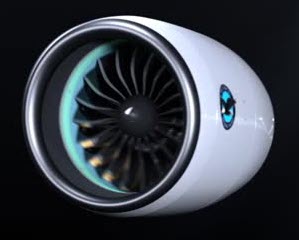
J74 1
In 2018 the USAF began looking at a re-engine program (again) for the Boeing B52H, named “Commercial Engine Re-engining Program (CERP)”. It is aimed at updating the current Pratt & Whitney TF33 engines with a commercial off-the-shelf engine.
The original B52’s were powered by the P&W J57. In 1961 the B52H was delivered with the TF33 powerplants. There are over 600 engines in inventory today powering over 70 B52H aircraft. The TF33 also powers the E-3 AWACS, E-8C, KC135 and has been retired on the C141.
The USAF plan is to stay with the eight-engine configuration utilizing current regional jet and business jet engines. Previous studies with four engines resulted in ground clearance issues, yaw effects and interference with flaps/control surfaces and it was proposed as an engine leasing model, but the economics were not there. The TF33, a workhorse of the USAF, is increasing in maintenance cost, lacks good fuel efficiency and is environmentally unattractive.
The B52H is expected to stay in the USAF inventory beyond 2050. It accounts for approximately half of the USAF bomber inventory. Modernization of the aircraft with new engines would improve fuel consumption by more than 30%, noise reduction of 30% and will provide a smaller carbon footprint. This Program is estimated to have a potential of 10 billion dollars in tax-payer savings over the program life and provides the warfighter with increased range capability, fewer tankers required and increased time on station.
The new engines will be easier to maintain, more reliable and more fuel-efficient thereby reducing the cost of ownership. Based on typical B52H utilization, the proposed engines would not come off-wing before 2050.
So what are the offerings:
General Electric is proposing two engines (1) The CF34-10 currently used on the Embraer E-190/195 rated at 20,000lbs of thrust and with 30 Million hours in-service experience. The expected fuel burn improvement relative to the TF33 is 20%. (2) The new Passport series engine introduced on the Global 7000 business jet. This engine will improve fuel burn by 30% but has less in-service experience.
Pratt and Whitney is offering the PW800 engine which currently powers the Gulfstream G500, G600 and was selected on the Dassault Falcon 6X. It provides up to 20,000lbs of the thrust and improves fuel burn by 30 – 35% relative to the TF33 and is 75% quieter The high-pressure spool of this engine (HPC, combustor, HPT) is equivalent to the PW1500G Geared Turbofan engine that powers the Airbus A220 which has accumulated over 740,000 flight hours.
Rolls-Royce is proposing the F130 series engine which is the military version of the BR700 commercial family. It is currently part of the USAF inventory flying on the RQ-4 Global Hawk(F137), C-37 (BR710) and E-11BACN (BR710). The BR710 commercial engine series also powers the Bombardier Global Express and Gulfstream V. The BR725 version powers the Gulfstream G650 with up to 17,000 pounds of thrust. There has been no word on whether Rolls-Royce would offer the Pearl series engine.
There are a number of items that need to be considered in the USAF CERP engine offering.
- Integration of electronic engine controls in a hydro-mechanical TF33 aircraft. All proposed engines are equipped with FADEC’s.
- Nacelle/Pylon integration of high by-pass ratio engines. The TF33 has a by-pass ratio of 1.4 compared to the newer engines with 5.5 BPR. The plan is to continue with two engines podded together. Fan Diameters of the new engine offerings range from 48 inches to 57 inches in comparison to the TF33 which is 53 inches.
- Sustainment model – Will this be “power by the hour” or will the USAF stand-up a depot? Can these engines make the 30,000-hour time on-wing target?
- Engine reliability will be important – Will the USAF trade engine performance for reliability?
- Pricing – Without spare parts and overhaul revenue for the engine manufacturers how does the USAF keep the deal attractive? The USAF and the engine manufacturers need to be creative.
Engine manufactures are anticipating an RFP release for CERP in the first half of 2020. This will further define the requirements. By the way – the B52 is informally referred to as the BUFF (Big Ugly Fat Fella).
More on engine details to follow in the next installment.
Views: 83




Big ugly fat fella… We all know that’s not the real name of that plane 😉
Very unacceptable name for the greatest bomber in history as well as incredibly badass. I was born with the B-52. It is awesome.